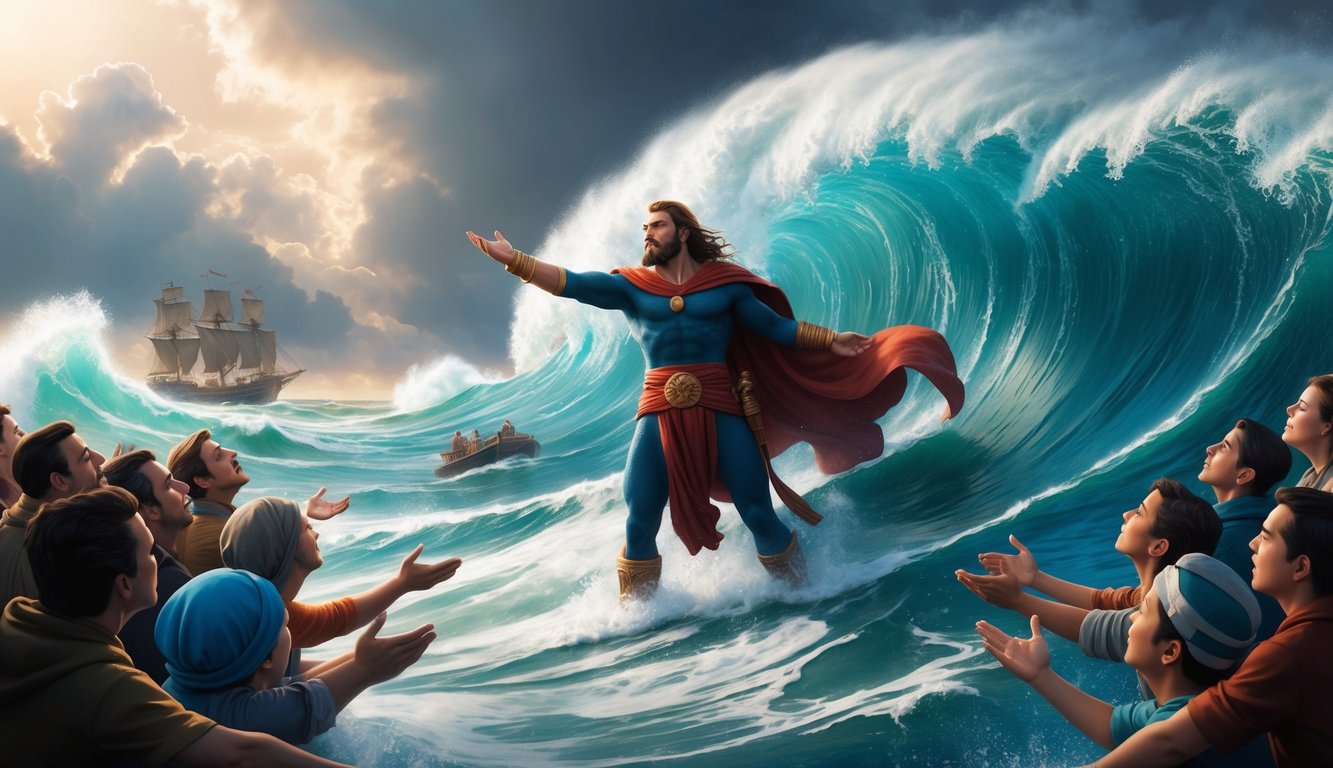Don’t Miss Out On This Unique Astrological Opportunity
Are you tired of spinning your wheels and getting nowhere? Simply put, you’re out of sync: you’re out of alignment with your astral configuration.
But: there’s a kind of map that can help you reclaim your alignment. Think of it as your own personal blueprint to success and happiness: a blueprint that will help you live your most amazing life.
Get started here.
Matthew 8 offers a fascinating glimpse into the life and teachings of Jesus as recorded in the Gospel of Matthew.
This chapter is rich with stories that highlight miraculous healings and powerful displays of authority over nature and spirits. In Matthew 8, Jesus demonstrates his divine power through a series of healings and the calming of a storm. These events not only show his compassion but also reveal deep theological insights about faith and authority.
As you explore Matthew 8, you will encounter various individuals who come face-to-face with Jesus and experience life-changing miracles.
These passages invite you to reflect on the impact of Jesus’s teachings and the significance of his encounters with people from different walks of life.
From a centurion’s unwavering faith to the healing of Peter’s mother-in-law, each story carries valuable lessons.
In addition to miracles, Matthew 8 emphasizes Jesus’s command over nature and spiritual realms.
The calming of the storm demonstrates his control over the natural world, while the encounter with demons in Gedara underscores his supreme authority.
These narratives deepen our insight into Jesus’s character and mission.
Key Takeaways
- Matthew 8 showcases Jesus’s healing miracles and authority.
- The chapter highlights significant encounters and teachings.
- Jesus’s control over nature and spirits reveals profound theological insights.
The Healing Miracles of Jesus
In Matthew 8, you find stories of Jesus performing miraculous healings.
These accounts illustrate his divine authority and compassion.
Key episodes include Jesus helping a centurion’s servant, a man with leprosy, and Peter’s mother-in-law, showcasing his ability to heal through faith and touch.
Healing of the Centurion’s Servant
In this story, a Roman centurion approached Jesus in Capernaum, requesting healing for his servant who was gravely ill.
Despite being a man of authority, the centurion displayed great humility and faith.
He believed Jesus could heal his servant with a mere word, acknowledging Jesus’ spiritual power.
Jesus was moved by the centurion’s faith and declared the servant healed without needing to visit the home.
This event underscores the importance of faith and how it can transcend barriers such as status and ethnicity.
You can explore more about the centurion’s faith and Jesus’ response in the text available at Significant aspects of the healing miracles in Matthew.
Cleansing of the Leper
Jesus encounters a man suffering from leprosy who approached him with faith and a respectful plea to be made clean.
Lepers during that time were often outcasts, and their condition was seen as unclean under the Law of Moses.
Despite the social norms, Jesus reached out and touched the man, saying, “Be clean!”
Immediately, the leprosy left the man, and he was healed.
Jesus instructed him to show himself to a priest and offer the gift Moses commanded.
This miracle illustrates Jesus’ disregard for societal barriers and his compassion for those suffering.
More about this transformational event can be read at Observations on the “Miracle Chapters” of Matthew 8-9.
Healing Peter’s Mother-in-Law
When Jesus entered Peter’s house, he saw Peter’s mother-in-law lying sick with a fever.
Without hesitation, Jesus touched her hand, and the fever left her.
She immediately got up and began to serve them, showing a complete and instant recovery.
Jesus’ touch demonstrates his power over physical ailments and his willingness to heal in close, personal settings.
This act of healing, though simpler in narrative than others, illustrates his continual compassion and readiness to restore health and vitality to those in need.
More insights can be gathered from Jesus as Healer in the Gospel of Matthew.
Teachings and Encounters
Matthew 8 presents significant moments in Jesus’ ministry where key teachings and miraculous encounters highlight themes of faith, discipleship, and the demands of following Him.
You’ll discover stories that emphasize the dedication and trust required to be part of Jesus’ journey.
The Cost of Following Jesus
In Matthew 8, Jesus addresses the cost of discipleship when a scribe expresses a desire to follow Him.
Jesus responds by highlighting how the Son of Man has no permanent home, unlike foxes with dens and birds with nests.
This serves as a reminder that followers, including scribes or anyone eager to learn from this great Teacher, must be ready for sacrifices and uncertainties.
Following Jesus demands dedication that surpasses material comforts and predictability in life.
Another potential follower mentions a desire to bury his father first.
Jesus instructs him to “let the dead bury their own dead.” This teaching underscores prioritizing spiritual commitments over traditional or familial responsibilities.
Commitment to Jesus requires putting Him above all else, even culturally significant duties.
The Faith of the Centurion
The encounter with the centurion showcases a powerful example of faith.
When this Roman officer approaches Jesus seeking healing for his servant, he demonstrates humility and belief in Jesus’ authority.
The centurion, recognizing his own unworthiness, expresses faith that Jesus’ word alone is enough to heal from a distance.
This account amazes Jesus, prompting Him to remark on the centurion’s exceptional faith—particularly noteworthy because he is not an Israelite.
This incident shows the inclusiveness of Jesus’ ministry, embracing even those from Greek or non-Jewish backgrounds who display such profound belief.
The centurion’s story is a testament that faith is not limited by cultural or religious boundaries.
Discipleship and Devotion
Jesus’ call to discipleship involves complete devotion and unwavering faith.
The narrative in Matthew portrays this through various encounters where disciples are challenged in their commitment.
As they witness miracles and teachings, it’s clear that being a disciple isn’t merely about proximity to Jesus but involves deep personal transformation and dedication.
In teaching His followers, Jesus emphasizes faith that goes beyond mere admiration or academic interest, like that of a teacher of the law or scribe.
Discipleship requires active participation and living out the values Jesus taught, even when faced with obstacles or societal expectations.
This commitment remains at the heart of what it means to truly follow Him.
The Authority Over Nature and Spirits

In Matthew 8, significant events demonstrate Jesus’ control over both natural forces and spiritual entities.
This includes calming a storm and exorcising demons, showcasing his divine power and authority.
Calming the Storm at Sea
As you read about this event, Jesus and his disciples are on a boat when a sudden storm threatens them.
The boat is rocked by strong winds and waves.
Despite the chaos, Jesus remains calm and asleep, while the disciples are filled with fear.
They wake him, pleading for help.
With just a rebuke, Jesus commands the waters and winds to settle.
Immediately, the storm ceases, leaving the sea calm.
This act reveals his authority over nature and challenges the disciples’ faith.
His question, “Why are you afraid, O you of little faith?”, highlights the importance of trust.
Exorcising Demons in Gadarenes
This event takes place as Jesus arrives in the region of Gadarenes.
He encounters two demon-possessed men living in the mountainside, known for their violent demeanor.
The demons recognize Jesus as the Son of God and beg not to be tortured before the appointed time.
They plead to be sent into a herd of pigs nearby.
When Jesus agrees, the demons enter the pigs, causing the entire herd to rush down a steep bank and drown in the water.
Witnessing this, the town’s people become afraid and urge Jesus to leave.
The incident shows his control over spiritual realms, emphasizing both power and compassion.
Theological Insights and Revelations

Matthew 8 offers profound insights into the nature of Jesus, the essence of faith, and the fulfillment of prophecy.
It captures the blend of divine authority and compassion in Jesus’ actions.
Jesus’ Identity Proclaimed
In Matthew 8, Jesus demonstrates his identity as the Son of God through his miraculous deeds.
When he calms the storm, his followers marvel, questioning his divine authority.
This authority is further evident when he casts out evil spirits, which recognize him and call him the Son of God.
These acts not only affirm his divine identity but also establish his power over nature and darkness.
Jesus’ ability to perform such acts highlights his fulfillment of the role predicted by the prophet Isaiah.
Concept of Faith and Healing
The chapter showcases the link between faith and healing, emphasizing that belief is crucial to receiving God’s power.
When a centurion asks Jesus to heal his servant, he exhibits profound faith by acknowledging that Jesus can heal from a distance.
Jesus is amazed by this faith, stating that it is unlike any he has seen in Israel.
This story underlines the importance of faith as a path to healing and connection with God‘s authority.
It also stresses that faith knows no boundaries, transcending cultural and geographical lines between east and west.
The Kingdom of Heaven and Prophecy Fulfilled
Matthew 8 also explores the concept of the Kingdom of Heaven through prophecies fulfilled by Jesus.
His actions and teachings demonstrate the realization of promises made to key biblical figures like Abraham, Isaac, and Jacob.
Jesus warns about the consequences of a lack of faith, with images of weeping and gnashing of teeth to illustrate separation from God.
This message serves as a reminder of Isaiah’s prophecy, urging you to seek light over darkness and embrace the promised kingdom.
These elements affirm the unfolding of God’s word through Jesus’ life and align with prophecies, solidifying his role in the divine plan.
Frequently Asked Questions

Matthew 8 presents various stories that highlight Jesus’ power and compassion.
You learn about His ability to calm storms, the strength of faith, the power behind healing miracles, and His encounters with different individuals.
What does the story of Jesus calming the storm in Matthew 8 symbolize?
The story where Jesus calms the storm illustrates His mastery over nature.
It symbolizes His ability to bring peace amid chaos and reassures His followers of His protective power.
This event serves as a reminder of trusting Jesus in times of trouble.
How is faith exemplified in Matthew chapter 8?
Faith is a central theme in Matthew 8.
The acts of those seeking Jesus’ help show strong belief in His ability to heal and save.
Examples include the centurion’s faith in Jesus’ word and those who witnessed His miracles and trusted in His ability.
What lessons can be learned from the healing miracles in Matthew 8?
The healing miracles in Matthew 8 teach lessons about compassion, divine authority, and the transformative power of faith.
They highlight Jesus’ willingness to cross societal boundaries to offer help and His ability to heal both physical and spiritual ailments.
These miracles demonstrate that faith plays a crucial role in receiving healing, as seen in the centurion’s servant and the leper who approached Jesus with trust.
Similarly, the John 11 miracles and faith emphasize the power of belief in God’s ability to restore life, as shown in the raising of Lazarus.
Both accounts reveal that divine intervention is not limited by human expectations but is accessible to those who trust in Jesus’ authority.
Who were the two individuals Jesus encountered in Matthew 8:19-31, and what significance do they have?
Jesus encountered two demon-possessed men in Matthew 8:28-34.
Their restoration illustrates His authority over evil and shows His power to change the lives of those who are afflicted.
This meeting also impacts the local people, who react with fear rather than faith.
In Matthew 8, how does Jesus’ interaction with the centurion illustrate His authority?
Jesus’ interaction with the centurion reveals that His authority is not limited by physical presence.
The centurion’s request for healing through Jesus’ command alone demonstrates faith in Jesus’ word.
This exchange emphasizes the reach and effectiveness of Jesus’ power.
What cultural and religious barriers does Jesus challenge in Matthew 8?
In Matthew 8, Jesus interacts with a Roman centurion and heals those considered outcasts.
His actions highlight inclusivity and emphasize that His message and compassion extend to all, regardless of societal status.



